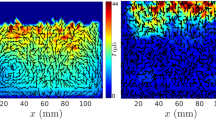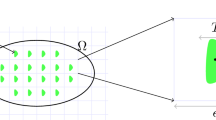Abstract
This paper describes the development of a computational framework that can be used to describe the electromagnetic excitation of rigid, spherical particles in suspension. In this model the mechanical interaction and kinematic behaviour of the particles is modelled using the discrete element method, while the surrounding fluid mechanics is modelled using the lattice Boltzmann method. Electromagnetic effects are applied to the particles as an additional set of discrete element forces, and the implementation of these effects was validated by comparison to the theoretical equations of point charges for Coulomb’s law and the Lorentz force equation. Oscillating single and multiple particle tests are used to investigate the sensitivity of particle excitation to variations in particle charge, field strength, and frequency. The further capabilities of the model are then demonstrated by a numerical illustration, in which a hydraulic fracture fluid is excited and monitored within a hydraulic fracture. This modelling explores the feasibility of using particle vibrations within the fracture fluid to aid in the monitoring of fracture propagation in unconventional gas reservoirs.







Similar content being viewed by others
References
Ladd AJC (1994) Numerical simulations of particulate suspensions via a discretized Boltzmann equation. Part 1. Theoretical foundation. J Fluid Mech 271:285
Ladd AJC (1994) Numerical simulations of particulate suspensions via a discretized Boltzmann equation. Part 2. Numerical results. J Fluid Mech 271:311
Cook BK, Noble DR, Williams JR (2004) A direct simulation method for particle-fluid systems. Eng Comput 21(2/3/4):151
Feng YT, Han K, Owen DRJ (2007) Coupled lattice Boltzmann method and discrete element modelling of particle transport in turbulent fluid flows: computational issues. Int J Numer Methods Eng 72(9):1111
McNamara GR, Zanetti G (1988) Use of the Boltzmann equation to simulate lattice-gas automata. Phys Rev Lett 61(20):2332
Chen S, Doolen GD (1998) Lattice Boltzmann method for fluid flows. Annu Rev Fluid Mech 30(1):329
Bhatnagar PL, Gross EP, Krook M (1954) A model for collision processes in gases. I. Small amplitude processes in charged and neutral one-component systems. Phys Rev 94(3):511
Chen H, Chen S, Matthaeus WH (1992) Recovery of the Navier–Stokes equations using a lattice-gas Boltzmann method. Phys Rev A 45(8):R5339
Qian YH, D’Humieres D, Lallemand P (1992) Lattice BGK models for Navier–Stokes equation. Europhys. Lett. 17(6):479
Owen DRJ, Leonardi CR, Feng YT (2011) An efficient framework for fluid-structure interaction using the lattice Boltzmann method and immersed moving boundaries. Int J Numer Methods Eng 87(1–5):66
Maier RS, Bernard RS, Grunau DW (1996) Boundary conditions for the lattice Boltzmann method. Phys Fluids 8(7):1788
Hou S, Zou Q, Chen S, Doolen G, Cogley AC (1995) Simulation of cavity flow by the lattice Boltzmann method. J Comput Phys 118(2):329
Sterling JD, Chen S (1996) Stability analysis of lattice Boltzmann methods. J Comput Phys 123(1):196
Lallemand P, Luo LS (2000) Theory of the lattice Boltzmann method: dispersion, dissipation, isotropy, Galilean invariance, and stability. Phys Rev E 61(6):6546
Dellar PJ (2003) Incompressible limits of lattice Boltzmann equations using multiple relaxation times. J Comput Phys 190(2):351
Zou Q, He X (1997) On pressure and velocity boundary conditions for the lattice Boltzmann BGK model. Phys Fluids 9(6):1591
Verberg R, Ladd AJC (2001) Accuracy and stability of a lattice-Boltzmann model with subgrid scale boundary conditions. Phys Rev E 65(1):1
Latt J, Chopard B, Malaspinas O, Deville M, Michler A (2008) Straight velocity boundaries in the lattice Boltzmann method. Phys Rev E 77:056703
Strack OE, Cook BK (2007) Three-dimensional immersed boundary conditions for moving solids in the lattice-Boltzmann method. Int J Numer Methods Fluids 55(2):103
Williams J, O’Connor R (1999) Discrete element simulation and the contact problem. Arch Comput Methods Eng 6(4):279
Munjiza A, Andrews KRF (1998) NBS contact detection algorithm for bodies of similar size. Int J Numer Methods Eng 43(1):131
Han K, Peric D, Owen DRJ, Yu J (2000) A combined finite/discrete element simulation of shot peening processes—Part II: 3D interaction laws. Eng Comput 17(6):680
Johnson SM, Williams JR, Cook BK (2008) Quaternion-based rigid body rotation integration algorithms for use in particle methods. Int J Numer Methods Eng 74(8):1303
Verberg R, Ladd AJC (2000) Lattice-Boltzmann model with sub-grid-scale boundary conditions. Phys Rev Lett 84(10):2148
Chun B, Ladd AJC (2007) Interpolated boundary condition for lattice Boltzmann simulations of flows in narrow gaps. Physi Rev E 75(6):066705
Aidun CK, Lu Y, Ding EJ (2000) Direct analysis of particulate suspensions with inertia using the discrete Boltzmann equation. J Fluid Mech 373(–1):287
Noble DR, Torczynski JR (1998) A lattice-Boltzmann method for partially saturated computational cells. Int J Mod Phys C 9(8): 1189
Leonardi CR, Jones BD, Holmes DW, Williams JR (2013) Simulation of complex particle suspensions using coupled lattice Boltzmann-discrete element methods. In: Mustoe G (ed) DEM 6: Proceedings of the 6th international conference on discrete element methods and related techniques. pp. 1–8
Holdych DJ (2003) Lattice boltzmann methods for diffuse and mobile interfaces. Ph.D. thesis, University of Illinois at Urbana-Champaign
Aidun CK, Clausen JR (2010) Lattice-Boltzmann method for complex flows. Annu Rev Fluid Mech 42(1):439
Ding EJ, Aidun CK (2003) Extension of the lattice-Boltzmann method for direct simulation of suspended particles near contact. J Stat Phys 112(3–4):685
Nguyen NQ, Ladd AJC (2002) Lubrication corrections for lattice-Boltzmann simulations of particle suspensions. Phys Rev E 66:046708
Hou LJ, Miskovic ZL, Piel A, Shukla PK (2009) Brownian dynamics of charged particles in a constant magnetic field. Physics of Plasmas 16(5):053705
Jesus Vd, Guimaraes A, Oliveira I (1999) Classical and quantum mechanics of a charged particle in oscillating electric and magnetic fields. Braz J Phys 29:541
Litvinenko Y (2003) Particle acceleration by a time-varying electric field in merging magnetic fields. Sol Phys 216(1–2):189
Han K, Feng YT, Owen DRJ (2010) Three-dimensional modelling and simulation of magnetorheological fluids. Int J Numer Methods Eng 84(11):1273
Pappas Y, Klingenberg D (2006) Simulations of magnetorheological suspensions in Poiseuille flow. Rheol Acta 45(5):621
Yiacoumi S, Rountree DA, Tsouris C (1996) Mechanism of particle flocculation by magnetic seeding. J Colloid Interface Sci 184(2):477
Lindner J, Menzel K, Nirschl H (2013) Simulation of magnetic suspensions for HGMS using CFD, FEM and DEM modeling. Comput Chem Eng 54(0):111
Hayt W, Buck J (2006) Engineering electromagnetics, 7th edn. McGraw-Hill, New York
Wolfson R (2007) Essential University Physics, vol 2. Pearson Addison Wesley, Boston
Knight R (2008) Physics for scientists and engineers: a strategic approach. Pearson Addison Wesley, Boston
Zohdi T (2010) On the dynamics of charged electromagnetic particulate jets. Arch Comput Methods Eng 17(2):109
Zohdi TI (2012) Electromagnetic properties of multiphase dielectrics: a primer on modeling, theory and computation, vol 64, 1st edn. Springer, Berlin
Zohdi TI (2012) Dynamics of charged particulate systems: modeling, theory and computation, vol 64, 1st edn. Springer, Berlin
Zohdi TI (2013) Electromagnetically-induced vibration in particulate-functionalized materials. J Vib Acoust 135(3):031007
Zohdi T (2014) Embedded electromagnetically sensitive particle motion in functionalized fluids. Comput Part Mech 1(1):27
Mukherjee D, Zohdi TI (2014) Electromagnetic control of charged particulate spray systems—models for planning the spray-gun operations. Comput Aided Des 46:211. 2013. SIAM Conference on Geometric and Physical Modeling
Mukherjee D, Zaky Z, Zohdi TI, Salama A, Sun S (2015) Investigation of guided-particle transport for noninvasive healing of damaged piping systems by use of electro-magneto-mechanical methods. SPE J: SPE-169639-PA
Moniz EJ, Jacoby HD, Meggs AJM (2011) The future of natural gas an interdisciplinary mit study. Technical report, Massachusetts Institute of Technology Energy Initiative
Bunger AP, McLennan J, Jeffrey R (eds) (2013) Effective and sustainable hydraulic fracturing. In: Tech. doi:10.5772/45724
Song F, Kuleli H, Toksoz M, Ay E, Zhang H (2010) An improved method for hydrofracture-induced microseismic event detection and phase picking. Geophysics 75(6):A47
Drew JE, Leslie HD, Armstrong PN, Michard G (2005) Automated microseismic event detection and location by continuous spatial mapping. In: Society of petroleum engineers annual technical conference. Society of Petroleum Engineers, SPE-95513-MS
Sleefe G, Warpinski N, Engler B (1993) The use of broadband microseisms for hydraulic fracture mapping
Kim DS, Lee JS (2000) Propagation and attenuation characteristics of various ground vibrations. Soil Dyn Earthq Eng 19(2):115
Sone H, Zoback M (2013) Mechanical properties of shale-gas reservoir rocks—part 1: static and dynamic elastic properties and anisotropy. Geophysics 78(5):D381–D392
Acknowledgments
Aspects of the hydrodynamic coupling of the LBM and DEM were presented in part at the 6th International Conference on Discrete Element Methods (DEM6) in 2013. This work was supported in part by the MITei-Saudi Aramco Seed Fund Scheme and this is gratefully acknowledged by the authors
Author information
Authors and Affiliations
Corresponding author
Rights and permissions
About this article
Cite this article
Leonardi, C.R., McCullough, J.W.S., Jones, B.D. et al. Electromagnetic excitation of particle suspensions in hydraulic fractures using a coupled lattice Boltzmann-discrete element model. Comp. Part. Mech. 3, 125–140 (2016). https://doi.org/10.1007/s40571-015-0035-x
Received:
Revised:
Accepted:
Published:
Issue Date:
DOI: https://doi.org/10.1007/s40571-015-0035-x




